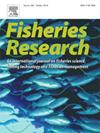Cormorant predation in fyke net fishing: The direct effects of a protected bird on coastal commercial fishing
IF 2.2
2区 农林科学
Q2 FISHERIES
引用次数: 0
Abstract
The population size of great cormorants, Phalacrocorax carbo sinensis, has risen steeply in the Baltic Sea over the past 40 years. The growing population has resulted in polarized conflicts between conservation and coastal fisheries due to the losses cormorants may inflict on fisheries. Mitigation of the conflicts requires objective estimates of true losses to fisheries, but quantitative research on losses has been scarce. We used continuous video-recordings to systematically quantify cormorant visits and their activity at 15 fyke nets during the 2022–2023 breeding and post breeding seasons. More than 2400 h of video footage were recorded, in which cormorants were found for 664 h. We also quantified the frequency of fish injured by birds in coastal fishing catches using data from the EU Fisheries Data Collection Program including data from fyke nets and gill nets. Our results show that cormorants frequently foraged in open, floating fyke nets but relatively rarely in submerged nets, leading to significantly higher losses in the former. Monitoring data from fyke and gill net catches covering the entire Finnish coast revealed that the proportion of bird-injured fish in catches is very modest (0.5 %) but can be considerable in individual catches. Finally, results indicate that cormorant visits and the proportion of injured fish in the catch tend to increase when distance to the nearest cormorant colony decreases. We conclude that the losses caused by birds are generally modest, except in open fyke nets where cormorants may conduct hundreds of dives and catch dozens of fish a day. Our study shows that cormorant depredation is highly variable in time and space, but also partly manageable by selecting gear that conforms to local cormorant pressures. We underline the importance of systematic scientific research when measuring damage caused by cormorants and ask for evidence-based political strategies to mitigate perceived cormorant problems.
海网捕鱼中的鸬鹚捕食:受保护鸟类对沿海商业捕鱼的直接影响
在过去的40年里,波罗的海的大鸬鹚(Phalacrocorax carbonsinensis)的数量急剧增加。由于鸬鹚可能对渔业造成损失,不断增长的人口导致了保护和沿海渔业之间的两极冲突。缓解冲突需要对渔业的真实损失进行客观估计,但对损失的定量研究却很少。在2022-2023年的繁殖季节和繁殖后季节,我们使用连续视频记录系统地量化了鸬鹚的来访和它们在15个网中的活动。拍摄了2400多个 小时的视频片段,其中发现了664只鸬鹚 小时。我们还使用来自欧盟渔业数据收集计划的数据,包括来自鱼网和刺网的数据,量化了沿海捕捞中被鸟类伤害的鱼类的频率。我们的研究结果表明,鸬鹚经常在开放的、漂浮的网中觅食,而很少在水下网中觅食,导致前者的损失明显更高。覆盖整个芬兰海岸的渔网和刺网渔获监测数据显示,被鸟伤的鱼在渔获量中所占比例非常小(0.5 %),但在个别渔获量中可能相当大。最后,研究结果表明,当距离最近的鸬鹚群落的距离减小时,鸬鹚的访问次数和捕获中受伤鱼的比例有增加的趋势。我们得出的结论是,鸟类造成的损失通常是适度的,除了在开放式的网中,鸬鹚可能会进行数百次潜水,每天捕获数十条鱼。我们的研究表明,鸬鹚的捕食在时间和空间上是高度可变的,但也可以通过选择符合当地鸬鹚压力的装备来部分管理。我们强调在测量鸬鹚造成的损害时进行系统科学研究的重要性,并要求采取基于证据的政治策略来减轻感知到的鸬鹚问题。
本文章由计算机程序翻译,如有差异,请以英文原文为准。
求助全文
约1分钟内获得全文
求助全文
来源期刊

Fisheries Research
农林科学-渔业
CiteScore
4.50
自引率
16.70%
发文量
294
审稿时长
15 weeks
期刊介绍:
This journal provides an international forum for the publication of papers in the areas of fisheries science, fishing technology, fisheries management and relevant socio-economics. The scope covers fisheries in salt, brackish and freshwater systems, and all aspects of associated ecology, environmental aspects of fisheries, and economics. Both theoretical and practical papers are acceptable, including laboratory and field experimental studies relevant to fisheries. Papers on the conservation of exploitable living resources are welcome. Review and Viewpoint articles are also published. As the specified areas inevitably impinge on and interrelate with each other, the approach of the journal is multidisciplinary, and authors are encouraged to emphasise the relevance of their own work to that of other disciplines. The journal is intended for fisheries scientists, biological oceanographers, gear technologists, economists, managers, administrators, policy makers and legislators.
 求助内容:
求助内容: 应助结果提醒方式:
应助结果提醒方式:


